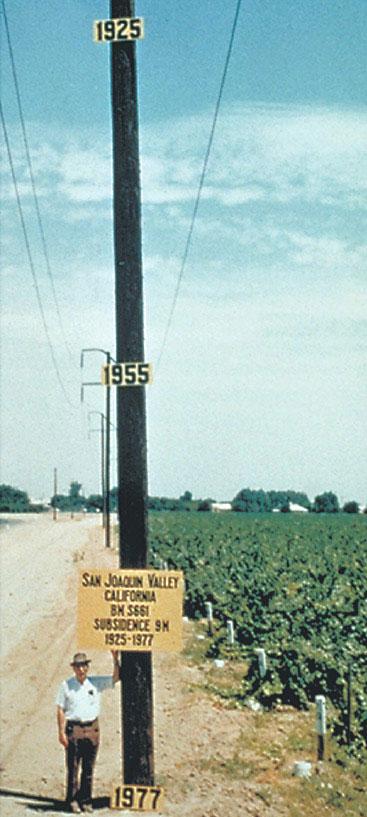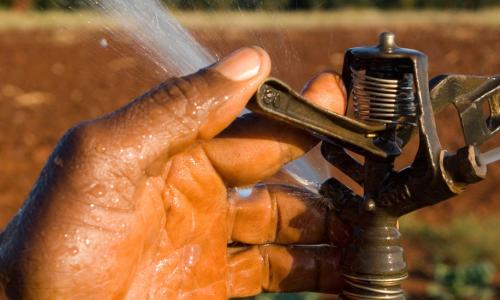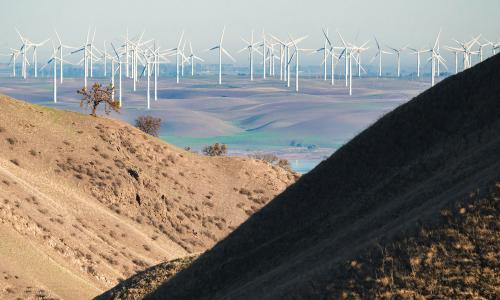Table of Contents
Global warming has significant implications for how we use — and sustainably manage — our groundwater supplies
When we think about the water we use to grow our food, to supply our homes and businesses, and to produce products, we typically think about water from lakes, rivers, and streams. But about a quarter of the water used in the U.S. actually comes from underground.
Soil holds water like a giant sponge, absorbing water from rain and runoff and serving as a natural water storage system. Wells are drilled to access this resource and, in many cases, pumps are used to suck groundwater out of the soil.
Under natural conditions, groundwater levels remain stable over time. But this natural balance can be upset if more groundwater is pumped out than is replaced. This condition, known as “overdraft,” has a number of significant consequences, including loss of stream flows, increased costs and energy use as wells are drilled deeper, ecosystem degradation, and potential salinization of groundwater due to seawater intrusion.
As the climate changes in response to global warming, longer and more severe droughts are projected for the western US The resulting dry conditions will increase the pressure on groundwater supplies as more is pumped to meet demand even as less precipitation falls to replenish it.
New approaches are needed to effectively prepare for our changing climate – and ensure that critical groundwater resources are protected for future generations.
How is groundwater used?
Agriculture uses the majority for crop irrigation (63% of total groundwater use nationwide), primarily in California, Arkansas, Texas, and Nebraska. Homes and businesses account for much of the rest (22%), followed by industry and mining (7%), and then thermoelectricity generation, aquaculture, and livestock watering (approximately 2% each).
It is important to note that groundwater use varies from year to year depending on conditions (the above estimates are from 2005, the most recent year available). In particular, groundwater use increases during droughts when there is less water available in lakes, rivers, and mountain snowpack.
For example, in California groundwater accounts for about 40% of the water used in normal years and up to 60% of the water used during droughts [1].

The consequences of groundwater overuse
Sustainable groundwater management means leaving enough groundwater in the ground to ensure safe and reliable water supplies not only for the short term, but for future generations as well.
Groundwater supplies are like a bank account – when inputs match outputs, groundwater levels remain stable. Groundwater levels decline when more groundwater is pumped out than is replenished. Groundwater levels have been declining for decades in many places in the Western US, such as California’s San Joaquin Valley and the Ogallala Aquifer in the High Plains region.
As groundwater levels drop, a variety of negative consequences result: pumps must pull water up from deeper depths, increasing energy use; new wells are drilled and pumped, driving up costs; and groundwater tables drop lower, which may harm streams and ecosystems.
Unlike a bank account, however, groundwater cannot always be replenished quickly or easily. In some cases, there isn’t even a way to get enough surface water back into the ground in the first place.
For example, some aquifers are collapsing as groundwater is sucked out of the soil and groundwater pressure is reduced. In response, the land above actually drops, a process known as land subsidence. Once this has occurred, this groundwater storage space is essentially lost forever. In some areas of California, land is dropping by approximately one foot a year due to land subsidence [2].
The connections between groundwater and global warming
A growing body of scientific research concludes that increased temperatures and changing precipitation patterns are altering the timing and availability of water resources in the western United States [3]. With longer and more severe droughts projected for the region [4], groundwater will play an increasingly important role in both preparing for climate change and reducing the global warming emissions that are driving climate change in the first place.
For example, snowpack is expected to continue to decrease over the coming decades, reducing surface water supplies in the Western US [5] In such a situation, groundwater becomes particularly critical, providing a buffer during dry years that helps protect water supplies and ensures a reliable food supply [6].
Managing groundwater sustainably can also play an important role in mitigating climate change. We know that more energy is being used to pump groundwater from greater depths as groundwater levels decline throughout much of the Western US [7] With longer and more frequent droughts expected, groundwater pumping is a potential source of increased global warming emissions.
Solutions for sustainable groundwater use
Measure groundwater levels and monitor groundwater use. We can’t manage what we don’t measure. It is difficult to develop well-informed solutions without an understanding of how and why groundwater levels are changing – and in many states, groundwater measurement and monitoring are limited and incomplete.
In some cases, addressing this challenge may mean installing more monitoring wells or taking more measurements each year to capture seasonal fluctuations. In other cases, this involves providing access to well data so that managers and decision-makers can understand how to solve problems related to groundwater overdraft, including land subsidence.
Manage to achieve sustainable yield. In the late 1980s, the concept of sustainable development — meeting the needs of the present without compromising the ability of future generations to meet their own needs — led to a shift in groundwater management toward a “sustainable yield” of water retained in the ground.
Sustainable yield goes beyond simply balancing the groundwater bank account (i.e., ensuring that outputs do not exceed inputs). It also seeks to protect the multiple ecological and social benefits that groundwater provides, such as contributing to stream flow, supporting groundwater-dependent ecosystems, and protecting against land subsidence and seawater intrusion.
To accomplish this, sustainable yield typically allows only a portion of groundwater recharge to be withdrawn. Or, returning to the bank account metaphor, sustainable yield requires that you leave a rainy-day fund in your account so that you don’t overdraw or bounce checks.
Track the energy intensity of groundwater pumping. As droughts and decreased snowpack limit surface water supplies, a shift to groundwater is occurring in many areas. In addition, satellite data shows that groundwater levels are dropping in some of the most groundwater-dependent regions, which means more energy for pumping will be needed in the future.
At the same time, there is little data on how much energy is used for groundwater pumping nationwide and how it is changing over time. It is important to effectively track this energy usage, gain a better understanding of the global warming emissions associated with water use, and develop new approaches to groundwater management.
It’s time to protect this critical resource for future generations.
References:
[1] California Water Foundation. Recommendations for Sustainable Groundwater Management. (2014). http://www.californiawaterfoundation.org/uploads/1399077265-GroundwaterReport-5-2014(00249329xA1C15).pdf
[2] Sneed, Michelle, Brandt, Justin, and Solt, Mike, 2013, Land subsidence along the Delta-Mendota Canal in the northern part of the San Joaquin Valley, California, 2003–10: U.S. Geological Survey Scientific Investigations Report 2013–5142, 87 p., http://dx.doi.org/10.3133/sir20135142. ISSN 2328-0328 (online)
[3] IPCC, 2013: Summary for Policymakers. In: Climate Change 2013: The Physical Science Basis. Contribution of Working Group I to the Fifth Assessment Report of the Intergovernmental Panel on Climate Change [Stocker,
T.F., D. Qin, G.-K. Plattner, M. Tignor, S.K. Allen, J. Boschung, A. Nauels, Y. Xia, V. Bex and P.M. Midgley (eds.)]. Cambridge University Press, Cambridge, United Kingdom and New York, NY, USA.
[4] Sheffield, Justin, and Eric F. Wood. “Projected changes in drought occurrence under future global warming from multi-model, multi-scenario, IPCC AR4 simulations.” Climate Dynamics 31.1 (2008): 79–105.
U.S. Global Change Research Program. Global Climate Change Impacts in the United States, Thomas R. Karl, Jerry M. Melillo, and Thomas C. Peterson (eds.). Cambridge University Press (2009).
[5] Daniel R. Cayan, Edwin P. Maurer, Michael D. Dettinger, Mary Tyree, Katharine Hayhoe. 2008. Climate change scenarios for the California region. Climatic Change 87 (Suppl 1):S21–S42
[6] Taylor, Richard G., Bridget Scanlon, Petra Döll, Matt Rodell, Rens van Beek, Yoshihide Wada, Laurent Longuevergne, Marc Leblanc, James S. Famiglietti, Mike Edmunds, Leonard Konikow, Timothy R. Green, Jianyao Chen, Makoto Taniguchi, Marc F. P. Bierkens, Alan MacDonald, Ying Fan, Reed M. Maxwell, Yossi Yechieli, Jason J. Gurdak, Diana M. Allen, Mohammad Shamsudduha, Kevin Hiscock, Pat J.-F. Yeh, Ian Holman and Holger Treidel. 2013. Ground water and climate change. Nature Climate Change, 3: 322-329.
[7] Famiglietti, J. S., M. Lo, S. L. Ho, J. Bethune, K. J. Anderson, T. H. Syed, S. C. Swenson, C. R. de Linage, and M. Rodell. (2011): Satellites measure recent rates of groundwater depletion in California’s Central Valley, 38, L03403, DOI:10.1029/2010GL046442.




